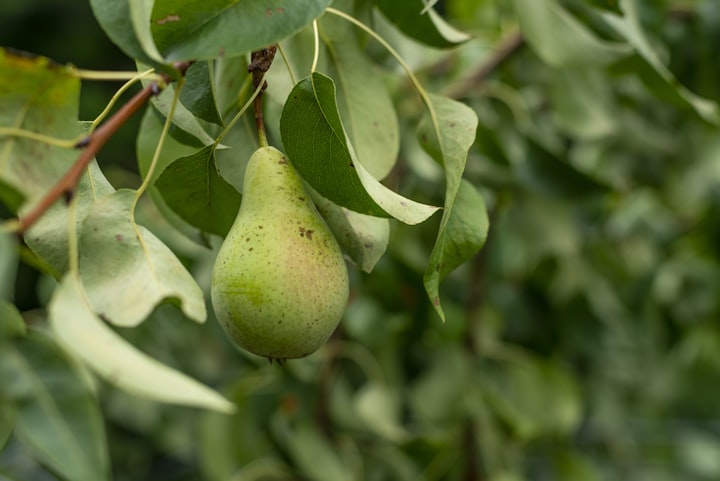
One of the natural organic product trees universally, the usual pear, is developed in all calm zone nations of the two halves of the globe. The organic product is regularly eaten new or is canned. It is utilized to deliver perry, a cocktail. A few animal varieties, like the Callery pear (P. calleryana), are developed as ornamentals.
The standard pear tree is expansive-headed and up to 13 meters (43 feet) high at development. The trees are seemingly perpetual (50 to 75 years) and may arrive at impressive size except if painstakingly prepared and pruned.
The roundish to oval, rugged leaves, to some degree wedge-formed at their bases, show up about similar times as the blossoms, which are about 2.5 cm (1 inch) wide and typically white. For the most part, Pear blossoms are white or pink and have five petals and sepals; the foundations of the five styles are isolated.
Pear natural products generally are better and gentler in surface than apples and are recognized by complex cells in the tissue, the alleged coarseness, or stone cells.
By and large, natural pear products are lengthened, tight at the stem end, and more extensive at the far edge. Pears are typically spread by sprouting or joining onto a rootstock, as a rule of Pyrus communis beginning.
In Europe, the focal rootstock utilized is quince (Cydonia oblonga), which delivers a predominated tree that natural products sooner than most trees on pear rootstocks.
The average pear is presumably of European beginning and has been developed since old occasions. Early Spanish ministers conveyed the natural product to Mexico and California.
In most pear-developing nations outside Asia, by a long shot, the most broadly developed pear assortment is Williams' Bon Chrétien, referred to in the United States as Bartlett. In the United States and Canada, mixtures, for example, Beurré Bosc, D'Anjou, and Winter Nelis are developed.
A typical sort in England and the Netherlands is Conference. Everyday Italian assortments incorporate Curato, Coscia, and Passe Crassane, likewise well-known in France. In Asian nations, the pear crop involves neighborhood sorts of local species, like the Asian or Chinese pear (P. pyrifolia).
Like different individuals from the rose family, Pyrus species are, for the most part, vulnerable to fire scourge, anthracnose, blister, and good buildup. A few animal varieties, mainly the Callery pear and its cultivars, are obtrusive and effectively get away from development in regions outside their regular reach.
A fire scourge, a plant illness brought about by Erwinia amylovora, can give poisonous plants a burned appearance. The fire curse prevalently influences individuals from the rose family (Rosaceae). It has obliterated pear and apple plantations in quite a bit of North America, in pieces of Europe, and New Zealand, and Japan.
Numerous other monetarily significant rural and elaborate plants can likewise be influenced, including almond, apricot, cherry, cotoneaster, crabapple, blooming quince, hawthorn, loquat, medlar, mountain debris, plum, quince, raspberry, rose, serviceberry, and spirea.
Side effects of fire curse incorporate an abrupt brown to dark shrinking and passing on of blooms, natural product spikes, leaves, twigs, and branches.
Indeed helpless plants show up as though burned by fire and may pass on. Ulcers—marginally indented, surrounding, dull brown to purplish-dark sores with a sharp, frequently broke edge—structure on twigs, branches, and trunk, causing terminal dieback. Organic products are water-doused, later becoming brown or dark and withered. In warm, clammy spring climates, bacterial seepage drops appear outside "leftover" ulcers.
Creepy crawlies, wind, and downpours convey the overflowing microorganisms to contaminate new plants and tissues. The organisms spread intercellularly and up to 1.2 meters (4 feet) through vascular tissue in the wood during pre-summer and late-spring, obscuring and killing the tissue.
A trim level of the microscopic organisms overwinter at the edges of branch and trunk blisters, prepared to rehash the infection cycle beginning the accompanying spring about blooming time.
Fire scourge is hard to control, particularly in warm wet climate conditions. Tainted wood should be taken out in pre-fall, fall, or winter when the microorganisms are not effectively spreading. Copper bloom showers can be applied when plants initially start to blossom however are of restricted viability and can harm organic products.
Streptomycin showers have been utilized to forestall new diseases and have added to anti-infection safe episodes in specific spaces. Safe assortments of a few helpless plants have been created.
About the Creator
Aditya Gupta
Checkout all my social links at: https://linktr.ee/itsrealaditya
Founder @HakinCodes | Entrepreneur, Ardent Writer, Psychology Nerd






Comments
There are no comments for this story
Be the first to respond and start the conversation.